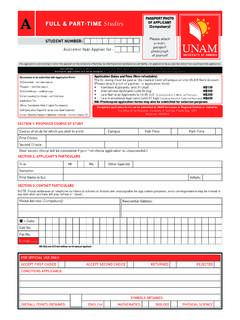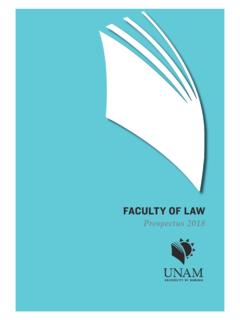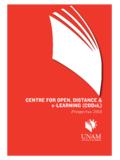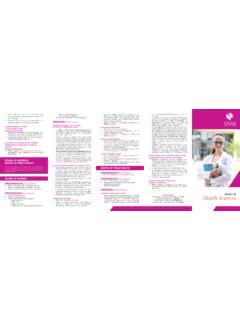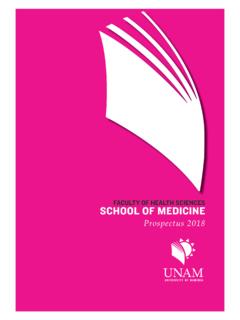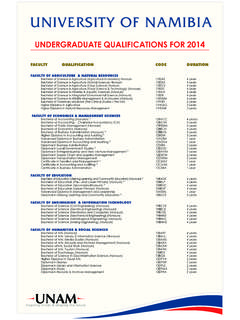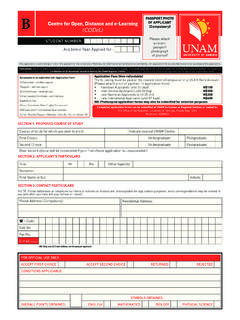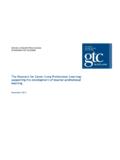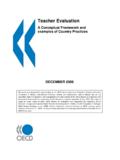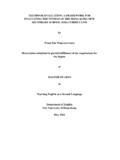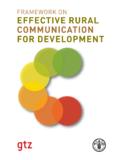Transcription of MONITORING AND EVALUATION FRAMEWORK
1 MONITORING AND EVALUATION FRAMEWORK FOR CONTINUING professional development 2012 1 1. About this guide and its applicability .. 2 2. The importance of M&E .. 3 3. Definitions .. 3 4. Types of Evaluations .. 4 5. Key M&E concepts: .. 5 6. CPD Results FRAMEWORK .. 5 What a CPD Results FRAMEWORK is used for .. 5 Characteristics of a CPD Results FRAMEWORK .. 6 7. Types of indicators, targets and means of verification .. 7 8. Methods of EVALUATION .. 8 9. Who should conduct the EVALUATION ? .. 8 10. Guidelines for deciding on EVALUATION methods .. 8 11. Data Quality Assessment FRAMEWORK : .. 10 12. What should the M&E Plan include? .. 12 13. Suggested outline for an EVALUATION 13 References .. 13 2 MONITORING and EVALUATION Implementation FRAMEWORK for Continuing professional development (CPD) 1. About this guide and its applicability MONITORING and EVALUATION (M&E) can be effective tools to enhance the quality of project planning and management.
2 MONITORING helps project managers to understand whether the projects are progressing in schedule and to ensure that project inputs, activities, outputs and external factors are proceeding as planned. EVALUATION can be a tool to help project managers assess to what extent the projects have achieved the objectives set forth in the project documents. This guide is a step-by-step process of using the proposed M&E Plan for CPD. It is expected that it will be used in different ways by different program interventions and at different stages of the strategy development and implementation process. However, it is very important to involve stakeholders and partners in each specific programme. The guide puts emphasis on the use of the Results FRAMEWORK approach, which is meant to be simple and straight forward in design and, therefore, it does not require specialized skills.
3 It is a systemic approach to documenting the logic of a strategy and its subsequent management, MONITORING and performance measurement to ensure that the intended results have been achieved. This Guide has been written for all those people who have specific yet different M&E-related responsibilities and tasks within the scope of CPD in the education sector. This makes it possible for the users to focus on the material that is relevant for their needs at a particular point in time. The user might want to copy parts of the Guide on particular M&E functions and use it in specific projects in CPD. 2. What does the Guide do? The objectives of this Guide are to provide the reader with: A basic understanding of the purposes, processes, norms, standards and guiding principles for planning, MONITORING and EVALUATION with the CPD context.
4 Knowledge of the essential elements of the planning and MONITORING and processes in CPD, developing a robust results FRAMEWORK for projects and programmes, with clear indicators, baselines and targets; and setting up an effective MONITORING system. Knowledge of the essential elements of the EVALUATION process in CPD: developing an EVALUATION plan, managing, designing and conducting quality evaluations, and using EVALUATION to develop intervention programmes. To enhance the results-based culture within CPD and improve the quality of planning, MONITORING and EVALUATION of education projects and programmes. 3 3. The importance of M&E MONITORING and EVALUATION is important because: it provides the only consolidated source of information showcasing project progress; it allows educators to learn from each other s experiences, building on expertise and knowledge; it often generates (written) reports that contribute to transparency and accountability, and allows for lessons to be shared more easily; it reveals mistakes and offers paths for learning and improvements; it provides a basis for questioning and testing assumptions; it provides a means for educators seeking to learn from each other s experiences and to incorporate them into policy and practice; it provides a way to assess the crucial link between implementers and beneficiaries on the ground and decision-makers.
5 It provides a more robust basis for raising funds and influencing policy. To ensure effective implementation and follow up, ongoing EVALUATION must be built into the implementation, based on predetermined critical success criteria for each learning initiative. EVALUATION should take place at different times: (before) pre-CPD interventions (known as diagnostic EVALUATION ), during a CPD intervention (known as formative EVALUATION ), and at the post-conclusion of a learning programme (known as summative EVALUATION ), or sometime after a learning programme (known as longitudinal EVALUATION ). Frequent interim evaluations must be conducted in order to prevent stagnation and encourage ongoing CPD programmes. The EVALUATION process should also include opportunities for revisitng the learning programme strategy in order to effect amendments and improvements (Meyers, 2002).
6 4. Definitions MONITORING is the routine checking of information on progress, so as to confirm that progress is occurring against the defined direction. It commonly involves monthly to quarterly reporting, on outputs, activities and use of resources ( people, time, money, and materials). It should be used to ensure that what has been planned is going forward as intended and within the resources allocated. EVALUATION is used to ensure that the direction chosen is correct, and that the right mix of strategies and resources were used to get there. It can typically be formative (helping to develop learning and understanding within stakeholders) or summative ( indicating the degree of achievement). It typically focuses on outcomes and their relationship with outputs. 4 5. Types of Evaluations EVALUATION timing Focus of EVALUATION Questions to ask Diagnostic EVALUATION Before delivery of the CPD programme The design of the programme Existing skills levels of learners as part of the CPD needs analysis Are the training and learning facilitation methods appropriate to achieve the outcomes?
7 Do the training methods coincide with the learners preference and learning styles? Has the learning programme been designed in the most efficient manner? Formative EVALUATION During the CPD intervention The quality of the delivery process The adequacy of the learning material The appropriateness of the delivery methods Are the learners enjoying the delivery of the programme? Are the methods being used in the delivery of the programme effective in achieving the programme objective and learning outcomes? What is the quality of the delivery of the learning programme? Are all the administrative arrangements running smoothly? Summative EVALUATION Directly after the CPD intervention Satisfaction of the learners with the learning programme The achievement of the outcomes by the learners The overall effectiveness of the learning programme Have the learners achieved the learning outcomes?
8 What are the learners assessment results? Was the learning programme effectively delivered? Did the learning programme achieve its overall objectives? What could we have done differently? What needs to be changed? How would we improve the learning programme? Longitudinal EVALUATION On the job 3-12 months after completion of the CPD intervention Transfer and application of learning in the workplace Support for new knowledge, skills and attitudes in the workplace Impact on individual performance in the workplace Impact on the performance of the education system 5 6. Key M&E concepts: Outcomes versus output, input, activities and impact Inputs: the human, financial and other resources expended in undertaking the activities. Activities: the things that need to be done to achieve outputs. Outputs: the major results needed to achieve the outcomes.
9 Outcomes: the long term benefits, intended or unintended. These can be relatively short-term ( during a project life, commonly referred to them as project purpose or objective) or long term, commonly referred to as goal or long-term objectives. Impacts: the result of achieving specific outcomes, such as improving learner performance. 7. CPD Results FRAMEWORK The Continuing professional development Results FRAMEWORK (CPDRF) is applied to monitor projects/programmes during implementation (with a view to taking corrective action) or to assess the results, or even the design of the completed projects. CPDFR addresses several long standing criticism of capacity development work, including the lack of clear definitions, coherent conceptual frameworks, and effective MONITORING of results.
10 It also promotes a common, systematic approach to capacity development by clarifying objectives, assess prevailing capacity factors, identify appropriate agents of change and change processes, and guide the design of effective learning activities. The FRAMEWORK addresses a gap often found between broad overall objectives and specific learning activities. The FRAMEWORK requires a defined set of variables to any developmental goal in a given context, and to model explicitly the change process that is expected to be facilitated by learning. Individuals and groups of teachers, teachers A CPDRF has two critical features, namely: Big picture perspective: a Results FRAMEWORK incorporates the contribution of stakeholders necessary to achieve relevant goals and objectives.
